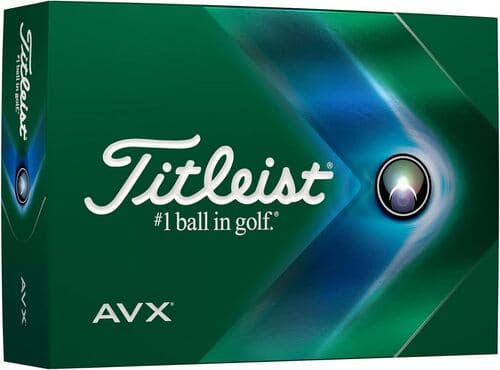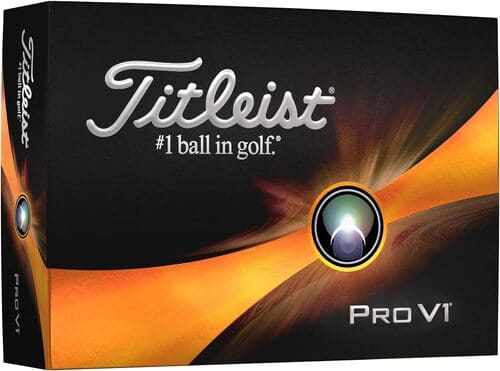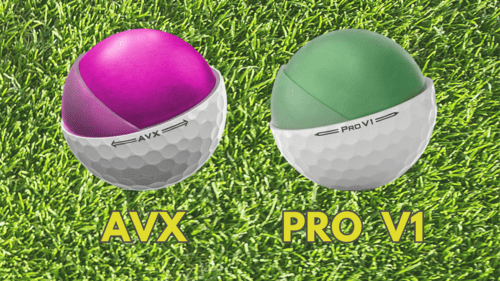Golf enthusiasts, buckle up for a journey into the heart of the game. Today, we’re dissecting the match-up between two heavyweights from Titleist – the AVX and the Pro V1. It’s not just about golf balls; it’s about unlocking your best shots!
Whether you’re a casual weekend golfer or harbor dreams of a green jacket (we all do, secretly), we’re dissecting the intricacies of these golf companions. No frills, just a balanced exploration of what sets these Titleist titans apart. So, grab your favorite iron and settle in – this blog post is your backstage pass to the AVX vs Pro V1 face-off!
Quick Overview
 Titleist AVX |  Titleist Pro V1 | |
|---|---|---|
| Construction | 3-Piece | 3-Piece |
| Cover Material | Urethane | Urethane |
| Compression | approx. 80 | approx. 90 |
| Driver Spin | Low | Medium |
| Iron & Wedge Spin | High | Very High |
| Feel | Very Soft | Soft |
| Recommended For Swing Speed | under 100 MPH | over 95 MPH |
Construction and Design Comparison
Layers
When it comes to choosing the right golf ball, understanding the construction is crucial. Both the Titleist AVX and Pro V1 are 3-piece golf balls, a common choice for golfers aiming for scores in the 70s or low 80s. The number of layers in a golf ball can impact performance, and these premium options are tailored for mid to low-handicap golfers.
2-piece balls, often preferred by average golfers shooting above 90, are cost-effective and have a lower compression rating, providing a suitable option for those prone to losing a few balls during a round.
3-piece balls, like the AVX and Pro V1, introduce a thin layer around the core to enhance short-game spin. Though pricier, they offer a performance boost and are recommended for those consistently shooting in the 80s, marking the transition to mid-handicap golf.
4 and 5-piece balls, the pinnacle of golf ball design, boast higher prices and increased spin. While beneficial for dialing in your short game, they might be less forgiving if you’re battling a significant slice.
Cover
Both the AVX and Pro V1, the top-tier contenders, boast urethane covers. This material choice ensures a premium feel, heightened spin, and optimal control around the greens. While slightly less durable than alternative covers like Surlyn or ionomer, urethane is the undisputed champion when it comes to delivering the finesse demanded by mid to low-handicap golfers.
Titleist AVX Construction
The AVX shares its 3-piece construction with the Pro V1 but sets itself apart with specific design features. Notably, the AVX is engineered to be low spinning off the tee, an attractive quality for golfers seeking lower shots. This characteristic can be advantageous for mid-cap players aiming to refine their ball flight.
Titleist Pro V1 Construction
The Pro V1, a stalwart in the golf ball market, also boasts a 3-piece construction. Recognized for its all-around excellence, the Pro V1 maintains its position at the top of the hierarchy. While the AVX leans towards a lower spin off the tee, the Pro V1 offers a balanced approach, catering to the comprehensive needs of golfers across various skill levels.
Performance Differences: Distance and Ball Flight
Distance
One of the critical factors for golfers is achieving optimal distance off the tee. Upon comparing the AVX and Pro V1, a nuanced distinction emerges. The AVX tends to offer a slightly longer distance, a potential game-changer for those looking to squeeze a few more yards out of their shots. This difference can be attributed to the AVX’s lower compression rating, making it well-suited for players with moderate swing speeds.
It’s worth noting that individual results may vary based on swing speeds. The AVX’s lower compression and slightly larger core could significantly impact distance, particularly for players with slower swing speeds.
Straightness
When it comes to keeping the ball on the fairway, the AVX takes a notable lead. The AVX’s design, emphasizing lower long-game spin, contributes to a straighter trajectory off the tee. For the average golfer struggling with excessive sidespin, this characteristic can be a game-changer. Straighter shots not only add distance but also make playing from the fairway considerably easier.
For golfers battling the common issue of too much sidespin, choosing a lower spinning ball like the AVX can be a strategic move to enhance accuracy and control.
Ball Flight
The distinction in long-game spin between the AVX and Pro V1 also influences ball flight. The Pro V1, with its medium spin off the tee, tends to produce a higher trajectory compared to the AVX. This becomes crucial, especially on windy days, where a lower ball flight can help combat the effects of the wind. Additionally, a lower ball flight often results in more rollout on the fairway, adding another layer of control to your game.
Spin and Control: Greenside Performance Comparison
Spin in golf is a multifaceted factor that significantly influences control, particularly in greenside situations. Understanding the different aspects of spin—backspin and sidespin—provides valuable insights into how the golf ball behaves on and around the putting surface.

Backspin
Backspin is the upward rotation of the ball, creating lift and promoting a high trajectory. This is crucial in short-game scenarios where golfers aim to land the ball on the green, allow it to take a controlled bounce, and then come to a swift stop. For mid to low-handicap golfers, a well-executed shot with backspin can mean the difference between the ball rolling past the pin and stopping close to the target.
Sidespin
Sidespin, on the other hand, determines the lateral movement of the ball. Too much sidespin can lead to hooks or slices, causing the ball to deviate from the intended path. In greenside situations, excessive sidespin can hinder precision and make it challenging to predict the ball’s final resting place.
How Spin Affects Ball Roll
The interplay between backspin and sidespin is crucial in determining how the ball behaves once it lands on the green. Backspin promotes a soft landing and controlled roll, ideal for stopping the ball close to the target. In contrast, sidespin can introduce unpredictability, affecting the direction and length of the roll.
Use of Spin for Slopes
Spin becomes a strategic tool when faced with sloping greens. Golfers can leverage backspin to counteract the effects of downhill slopes, preventing the ball from accelerating too rapidly. Conversely, on uphill slopes, a well-executed shot with sufficient backspin can help the ball hold its position on the green.
Understanding the nuances of spin empowers golfers to make informed decisions based on the contours of the course, enhancing overall control and performance around the greens.
AVX Vs. Pro V1: Spin Comparison
Both the AVX and Pro V1 are renowned for their high short-game spin, a key attribute for golfers seeking control and finesse around the greens. However, a nuanced difference emerges when comparing the two. The Pro V1 tends to exhibit slightly more spin, particularly beneficial for professionals who demand precise control over the ball’s movement.
While professionals may discern the subtle variations, the average golfer might find the difference negligible. For most golfers, the high spin rates of both the AVX and Pro V1 ensure reliable performance in the critical aspect of greenside control.
Feel and Compression: Sensory Experience Comparison
The feel of a golf ball is a subjective yet crucial aspect of the game, influencing the overall sensory experience for golfers. Compression, often measured through a numeric rating, plays a pivotal role in how a golfer perceives the impact and responsiveness of the ball during the swing.
What Effect Does Compression Have on Feel?
The compression rating of a golf ball, representing the amount of force required to compress the ball, directly impacts the feel at impact. In the case of the AVX and Pro V1, the AVX boasts a compression rating of approximately 80, while the Pro V1 is slightly higher at around 90. These mid to high-compression ratings make both balls suitable for golfers with average to above-average swing speeds.
AVX Vs. Pro V1: Feel Comparison:
Both the AVX and Pro V1 are acclaimed for their soft feel, offering golfers a responsive and satisfying sensation at impact. However, the AVX, with its lower compression, tends to feel a bit softer, providing a plush experience that resonates with players seeking a cushioned touch during ball striking.
Golfers often develop personal preferences regarding the feel of a golf ball. Some gravitate towards a softer sensation, appreciating the feedback and perceived control, while others might prefer a firmer feel for a sense of solidity during the swing.
Understanding the relationship between compression and feel allows golfers to align their ball choice with their sensory preferences, contributing to a more enjoyable and confident playing experience.
Choosing the Right Ball: Factors to Consider
Swing Speed
Selecting the right golf ball involves considering individual characteristics, and swing speed stands out as a fundamental factor. The AVX is classified as a mid-compression ball, with a compression rating of approximately 80. In contrast, the Pro V1 is a high-compression ball, boasting a rating closer to 90. Understanding your swing speed is crucial in determining which of these balls aligns best with your game.
AVG Swing Speed: The average golfer typically swings the club around 93 MPH. While this places most individuals in the mid-compression range, it’s essential to recognize that each player’s swing speed is unique. Golfers with a slower-than-average swing speed often benefit from a lower compression ball, promoting optimal energy transfer for increased distance.
High-Compression Consideration: Golfers with swing speeds exceeding 98 MPH may find the Pro V1 more suitable. This high-compression ball is designed to cater to faster swings, ensuring a balance between control and distance. Professional players, who often exceed 110 MPH, commonly favor high-compression balls like the Pro V1.
Handicap
Considering your handicap level is another crucial aspect when choosing between the AVX and Pro V1.
AVX for Mid to Low Handicaps: The AVX, with its focus on low spin and additional distance, is well-suited for golfers in the mid to low handicap range. Players who consistently shoot in the 70s or low 80s can benefit from the AVX’s characteristics, especially if they are looking to fine-tune their ball flight and gain extra yards off the tee.
Pro V1 for Comprehensive Performance: The Pro V1, known for its all-around excellence, is a preferred choice for a broad spectrum of handicap levels, including mid to low handicappers. Its balanced attributes across distance, spin, and control make it a reliable option for those seeking a versatile golf ball.
Personal Preferences
Ultimately, personal preferences play a significant role in selecting the right golf ball. Factors such as feel, response, and the overall experience contribute to a golfer’s connection with the game. Trying both the AVX and Pro V1 and considering how they align with your unique preferences can guide you towards the ball that enhances your enjoyment and performance on the course.
Final Thoughts
Choosing your golf ball sidekick – the AVX or the Pro V1 – is like picking the perfect club for a tricky shot. The AVX is the cool cat, rocking a mid-compression vibe, delivering a softer feel, and a touch more distance off the tee. If you want to dial in that hook or slice, the AVX is your partner in crime.
Now, the Pro V1, the seasoned veteran, brings a high-compression game to the table. It’s got a bit more spin, especially around the greens, making it the maestro of precision. For those who want the all-in-one package, the Pro V1 is like having a caddy who anticipates your every move.
In the end, it’s your golf story, and both these balls are A-listers. AVX for the thrill-seekers, Pro V1 for the all-around legends. Try ’em both, see which one speaks your golf language, and let the good times roll on the fairway!






